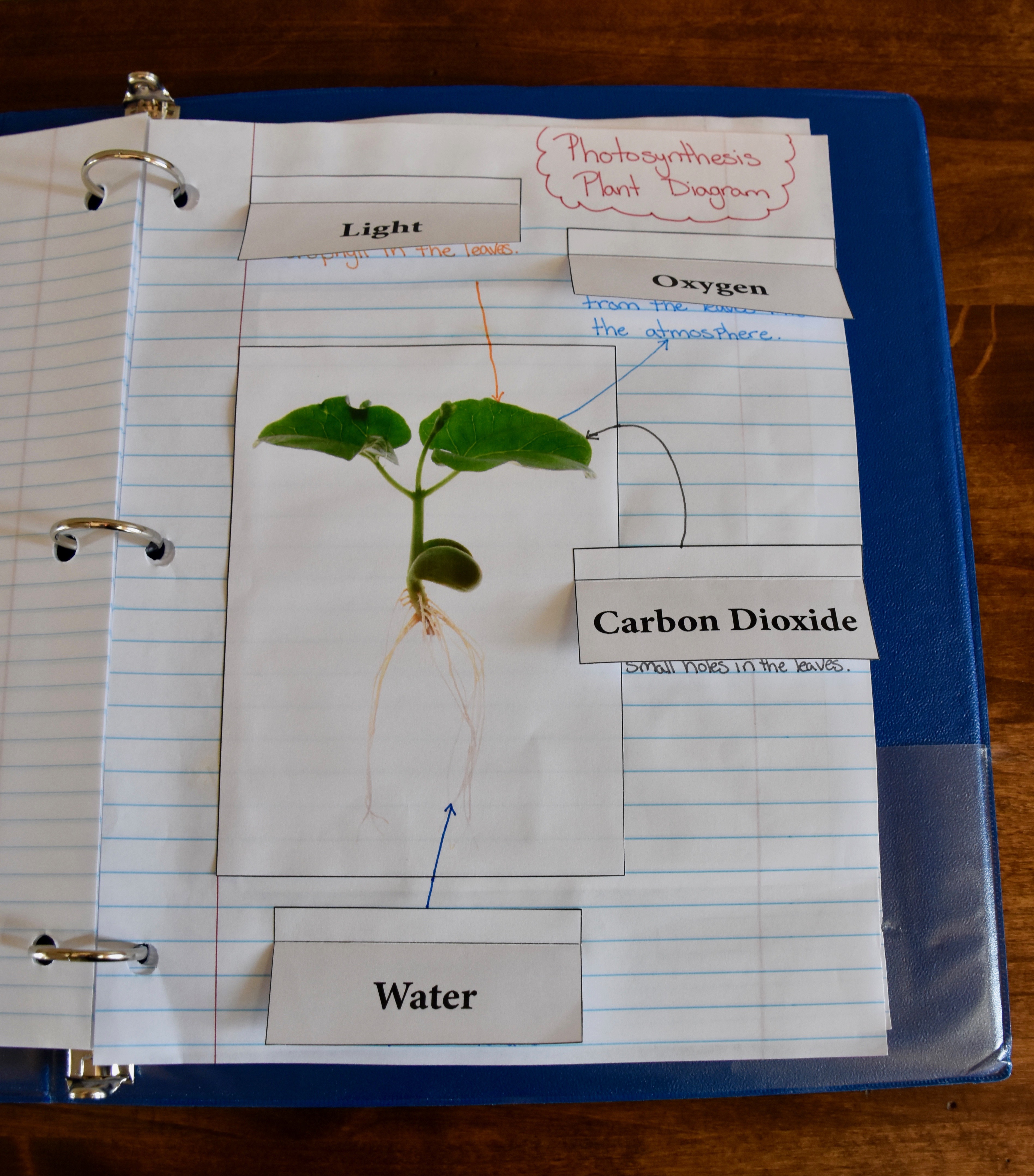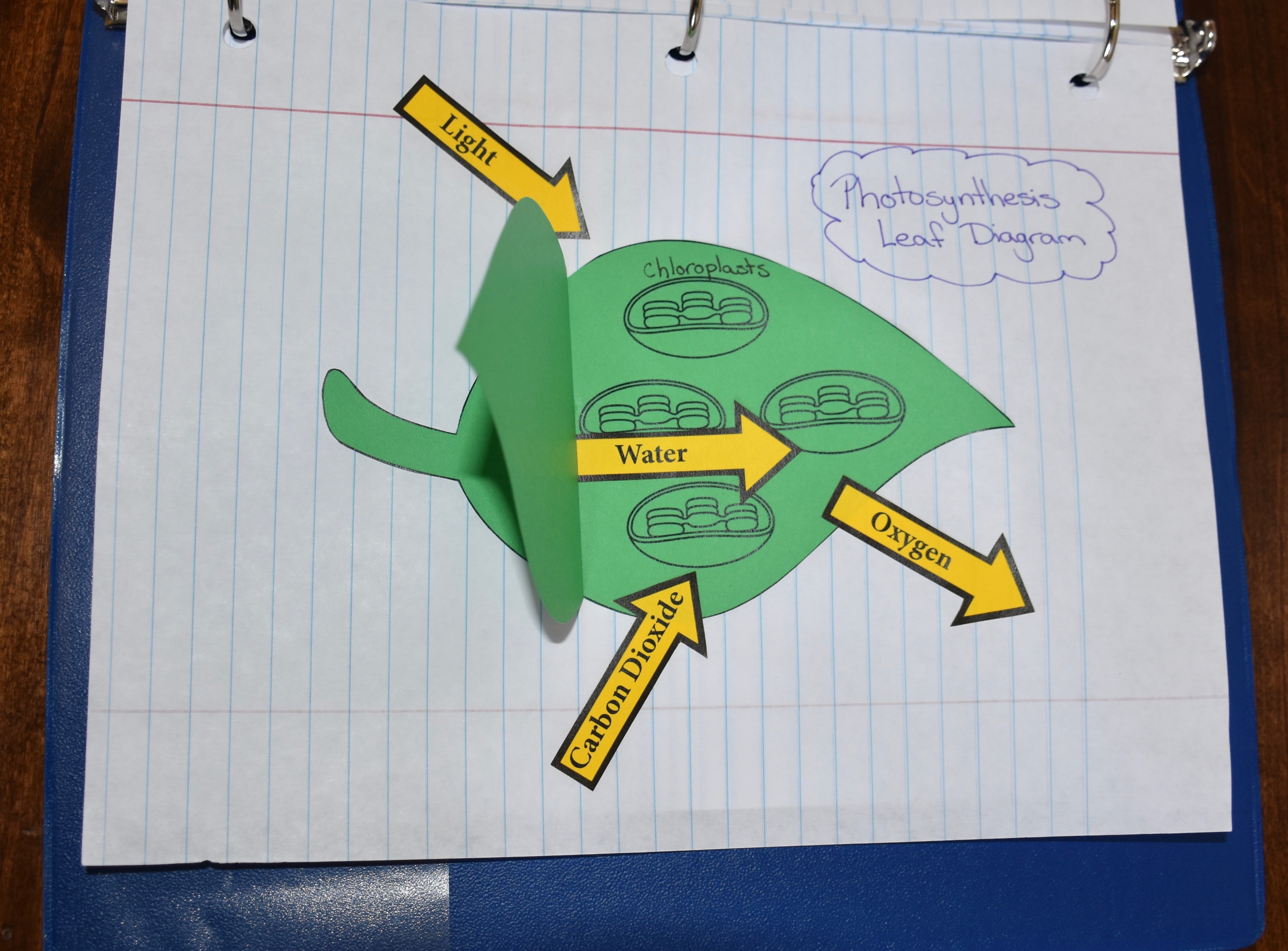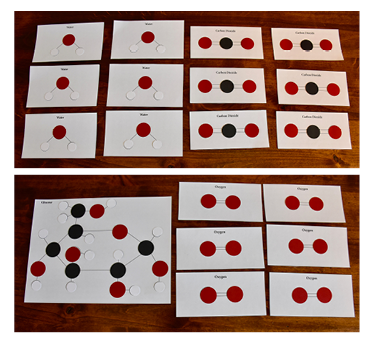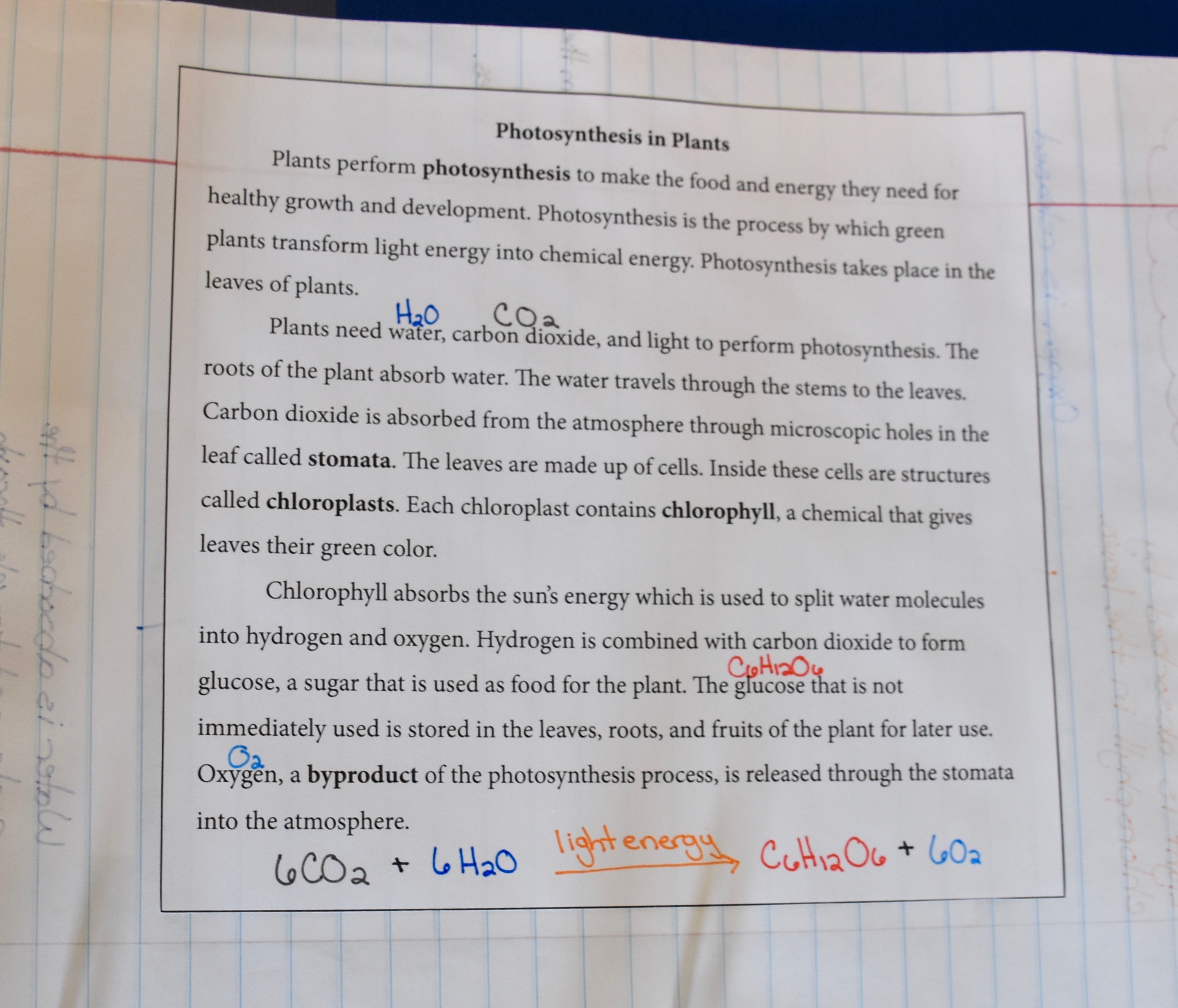 Relevancy and Engagement
www.agintheclass.org
Relevancy and Engagement
www.agintheclass.org
Photosynthesis: Energy's Journey From Farm to You
Grade Level
Purpose
Explore photosynthesis to discover how plants obtain energy from the sun and then continue following energy's path to see how energy can flow through ecosystems to ultimately provide food for humans. Grades 6-8
Estimated Time
Materials Needed
Engage:
- Energy's Journey from Farm to You slide deck
- 20-minute dairy farm field trip video
Activity 1: Photosynthesis
- Science notebook
- Photosynthesis Interactive Science Notebook Packet
- Glue sticks
- Scissors
- Interactive Periodic Table
- Molecular Model Cards, 6 carbon dioxide cards, 6 water cards, 6 oxygen cards, and 1 glucose card per group
- Atom Disks, 12 hydrogen atoms, 6 carbon atoms, and 18 oxygen atoms per group
- Flashlights, 1 per group
- Photosynthesis video
Activity 2: Energy from Plants to Cows
- Energy's Journey from Farm to You slide deck (continued)
- What Cows Eat video
Evaluation:
- Energy's Journey from Farm to You slide deck (continued)
Vocabulary
by-product: an incidental or secondary product made in the manufacture or synthesis of something else
digestion: the process of breaking down food by mechanical and enzymatic action into substances that can be used by the body
energy: power derived from the utilization of physical or chemical resources
nutrient: a substance that provides nourishment essential for growth and the maintenance of life
photosynthesis: the process by which plants convert carbon dioxide, water, and light energy into sugars and oxygen in order to store energy; the opposite of cell respiration
respiration: the process through which a plant exchanges oxygen and carbon dioxide with its environment
Did You Know?
- Every year in the United States 40% of edible food—about 34 million tons—is wasted. Using food waste and byproducts for animal feed can help to reduce this number.1
- The national average dairy cow ration includes 33 ingredients and contains 53% forage and 47% concentrate. Food, fuel, and fiber industry by-products (14 ingredients) account for 19% of dairy feed concentrate. Eight major crops account for 80% of dairy feed DM (corn 42%, alfalfa 22%, wheat 3.1%, soybean 3.0%, canola 1.8%, sorghum 1.7%, barley 1.4%, and cottonseed 1.4%).2
Background Agricultural Connections
Photosynthesis is the process by which green plants and certain other organisms transform light energy into chemical energy. Plants use the energy of light to convert carbon dioxide and water into sugar (glucose) and oxygen. Carbon dioxide is absorbed by the leaves through the stomata. Water enters the plant at its roots and travels through the stem to reach the leaves. The leaves are the primary site where the photosynthesis process takes place. Inside the leaf cells are structures called chloroplasts. Each chloroplast contains chlorophyll, a chemical that gives leaves their green color. When the leaves receive light, chlorophyll captures the light's energy and stores it to eventually be used to convert water into hydrogen and oxygen. The water's hydrogen and oxygen atoms are combined with the carbon dioxide's carbon and oxygen atoms to create glucose molecules which are used by the plant to produce its food. Oxygen, a byproduct of the photosynthesis process, is released into the atmosphere through the stomata. In plants, photosynthesis only occurs in the presence of light.
Light requirements vary by plant species. Green plants need light to perform photosynthesis, although the intensity, quality, and duration needs will differ by plant. Understanding the light preferences of a plant is important when choosing an appropriate planting location and/or light source.
A grow light is an artificial light source designed to stimulate plant growth by emitting a light appropriate for photosynthesis.1 The purpose of a grow light is to replicate the natural solar spectrum of sunlight or to provide a light spectrum tailored to the needs of a particular plant. There are three main types of grow lights—fluorescent, LED (light-emitting diodes), and HID (high-intensity discharge).2 Grow lights differ from traditional light bulbs that are used to light homes. Unlike a traditional light bulb, grow lights produce the full spectrum of light and appropriate intensity necessary for photosynthesis. Grow lights also produce less heat than a traditional bulb, which prevents the scorching of plants.
Plants differ in their light intensity requirements. For grow lights, light intensity is determined by a bulb's brightness and the proximity of the light source to the plant. Plants native to tropical jungles or shady forests typically require less light as compared to plants from dry, sunny climates.
All plants need a rest from light. Respiration, an important part of a plant's growth process, occurs when it's dark. Botanists usually divide plants into three categories relating to their preferred day length—short-day plants grow best with less than 12 hours of light per day, long-day plants require 14-18 hours of light per day, and day neutral plants depend on 8-12 hours per day all year long.
There is a constant flow of energy in our world. This results in an energy supply chain which begins with the sun. Energy is transferred along this chain in different forms, which is important because all the living things require energy in specific forms. Energy helps organisms live and grow.
Plants use photosynthesis to capture light energy from the sun and convert it into food energy plants need to grow. This process requires sunlight, carbon dioxide, and water, which combine and convert to glucose and oxygen.3 Humans and animals use respiration to obtain energy by combining oxygen and glucose, which results in the release of carbon dioxide, water, and ATP (cellular energy).
Cattle assist in the energy supply chain by converting energy that humans cannot use into energy that humans can use. Cattle have a four-compartment stomach which allow them to eat, digest, and use the energy from some parts of plants that humans cannot.5 This is the case with 75–80% of the feed dairy cows will eat.6 They eat byproducts like cotton seeds, almond hulls, distillers grain (leftover from processing cereal grains or beer), and sugar beet pulp.7 An animal nutritionist will help farmers decide exactly what goes into the feed to provide all the nutrients dairy cows need to grow and produce milk. Humans can then drink the milk the cows produce (or a variety of other dairy products) to get their own nutrition and energy. Dairy products provide a variety of nine essential nutrients, including all of the macronutrients (carbohydrates, fat, protein, and water). This makes dairy products an important part of a healthy diet for all age groups, and especially kids who are still growing.8
The movement of energy through the world is very important to keeping living things alive. It starts with the sun and plants through photosynthesis. Cows are then able to eat these plants (several that humans can't digest), use the energy to produce milk that humans can digest, and use the energy and nutrients to live and grow.
Engage
- Explain to students that they are going to look at three different meals that contain energy.
- Project slide 2 from the Energy's Journey from Farm to You slide deck. Ask students what products they recognize. Point to each picture and have students name the food items. They will likely recognize the foods on the left, but you may need to tell them that the food on the right is called silage. Silage is a grass or other green plant that was chopped up and stored in airtight conditions to be fed to animals. Ask the following questions to lead a class discussion:
- Ask students to raise their hand if they would like to eat each item for their next meal. (Point to each picture individually.)
- Discuss with the students why they did not choose silage (ex. it doesn’t look appetizing, never seen it before, humans can’t digest it).
- Ask why students like to eat food (tastes good, they are hungry, like to eat etc.). Try to pull out answers that refer to needing food so they aren’t tired and it gives them energy.
- Why do you need energy? Have you heard of it?
- What is energy?
- Which food item do you get energy from?
- Can you (a human) get energy from silage? Why?
- Can you think of an animal that might get energy from silage?

- Watch a 20-minute dairy farm field trip. Have students look for energy pathways as they are watching the field trip. Can they answer some of the questions that came up in the discussion?
Explore and Explain
Activity 1: Photosynthesis
- Ask the students, "What is the ultimate source of energy? See if the students can identify the sun. If needed, show slide six of the Energy's Journey from Farm to You slide deck as a hint and ask, "Why is light important for plants?" After listening to the students' responses, explain that they are going to explore this question.
- Explain that plants use energy from light to make food through a process called photosynthesis.
- Provide each student with a Photosynthesis Interactive Science Notebook Packet. Instruct the students to cut out the "Plant Diagram Cards."
- Using a glue stick, have the students glue the plant card onto a page of their science notebook.
- On the other four label cards, fold on the line, apply glue to the back of the tab, and attach the cards around the plant card so
that the light card is above the plant, the water card is below the plant, and the oxygen and carbon dioxide cards are along the side of the plant. - Underneath the label cards, describe the role each element plays in the photosynthesis process. Draw arrows to or from each label card to the part of the plant that is affected.The descriptions and arrows should be similar to the following:
- Light: Light is absorbed by the chlorophyll in the leaves. (Draw an arrow from the "Light" card to the leaf.)
- Oxygen: Oxygen is released from the leaves into the atmosphere. (Draw an arrow from the leaf to the "Oxygen" card.)
- Carbon Dioxide: Carbon dioxide from the air passes through small holes in the leaves (stomata). (Draw an arrow from the "Carbon Dioxide" card to the leaf.
- Water: Water is absorbed by the roots and travels through the stem to the leaves. (Draw an arrow from the "Water" card to the roots.)

- Allow time for the students to cut out and read the "Photosynthesis in Plants Reading." Discuss the definitions of any unfamiliar words. Have the students glue the reading onto the next page in their science notebooks.
- Instruct the students to cut out the "Leaf Diagram" shapes and glue the bottom leaf (the leaf with the chloroplasts) onto the next page in their science notebooks. Apply glue from the stem to the line on the bottom leaf. Attach the top leaf to the bottom leaf and fold the top leaf open at the glue line.
- Have the students cut out the "Arrows" and attach them to the leaf diagram to show how light, water, and carbon dioxide enter the leaf and how oxygen leaves the leaf.

- Show the students the Interactive Periodic Table and point out that it is a display of all of the known chemical elements. Locate hydrogen (H), oxygen (O), and carbon (C) on the periodic table.
- Help students understand that atoms are the smallest amount of an element and molecules are combinations of atoms connected by chemical bonds. Help the students record the chemical formulas of each molecule in the "Photosynthesis in Plants Reading"—water (H2O), carbon dioxide (CO2), glucose (C6H12O6), and oxygen (O2). Clarify that the number in the formula indicates the number of atoms of that element in the molecule. For example, H2O contains two atoms of hydrogen.
- Organize the class into partners or small groups. Provide each group with Molecular Model Cards—6 carbon dioxide cards, 6 water cards, 6 oxygen cards, and 1 glucose card. Pass out a section of Atom Disks—12 hydrogen atoms, 6 carbon atoms, and 18 oxygen atoms—for the groups to cut out.
- Have the students place the atoms onto the water and carbon dioxide molecular models. Turn off the lights and tell the students to shine their flashlights on the models to simulate light energy. Explain that, using light energy, the water molecules are split into hydrogen and oxygen. Hydrogen is combined with carbon dioxide to form glucose and oxygen. Instruct the students to transfer the atoms from the water and carbon dioxide molecules to the glucose and oxygen molecules.

- Help the students write the balanced chemical equation for photosynthesis on the bottom of their "Photosynthesis in Plants Reading" (6CO2 + 6H2O -Light Energy-> C6H12O6 + 6O2).

- Review the following with the students:
- The chlorophyll in a plant's leaves absorbs the energy from light.
- The light energy is used to split water molecules into hydrogen and oxygen.
- The hydrogen is combined with carbon dioxide to form glucose.
- Glucose is a sugar that is used as food for the plant or stored by the plant for later use.
- Oxygen is released through the stomata into the atmosphere.
- Summarize with the video, Photosynthesis.
Activity 2: Energy from Plants to Cows
- Summarize that so far we have learned that the ultimate source of energy is the sun and that the sun gives plants energy through the process of photosynthesis. Photosynthesis converts the sun’s energy into glucose, or sugar. (slide 7)
- Ask the students, “Who (or what) do you think can use this glucose, or sugar for energy?” Students may answer with humans or animals, and these are both correct. Point out that cows are the center of our energy chain today (slide 8).
- To better illustrate this step in the energy transfer, students need to learn a little more about what cattle eat. Watch, What Cows Eat.
- In reference to the virtual dairy tour, ask students, “What were some of the plants or food items the farmer showed us that cows eat?” Prompt them as necessary or show the pictures on slide 10.
- Point out that cattle can obtain nutrients from plants that humans cannot digest. Ask students, "Why do you think cattle have this ability? Help guide students to the correct answer, which is that cattle have this ability because they have a different digestive system. (slide 11-12) This multi-chamber stomach allows cattle to digest and gain nutrients from food that humans cannot.
- Show the pictures of some of the different plants cows eat (slide 13). Have the students guess the plant from the picture.
- Ask students, "How do humans use plants?" Use the examples on slide 14 to discuss a few plants that humans use.
- Define a byproduct as an incidental or secondary product made in the manufacture of something else.
- Explain that a share of what cattle eat are actually byproducts (slide 15).
- Cotton: After cotton is used for clothing, there is a seed byproduct that cows can eat. When it is fed to cows, it is known as cottonseed meal.
- Wheat: When wheat is processed, the byproduct of the grain not used in flour is called distillers grain.
- Alfalfa: This crop is grown, cut, and dried out to make hay.
- Corn: Explain to students that unlike humans, who only eat the kernels on the cob, cows can eat the entire corn stalk. The corn stalks are chopped into small pieces and kept very moist. This is called silage (seen on slide 2). Corn used for cow feed and silage is not the same variety of corn as sweet corn grown in gardens.
- Discuss the importance of not being wasteful and just throwing things in the garbage. Explain that there is an efficient way to use some of our “leftovers” or byproducts. As needed, explain the following concepts and show the pictures of how humans use the products.
- Explain to the students that a cow’s diet is 75–80% food that human’s can’t digest, or is part of the plant that we don’t use.6 This is another great thing about cows—they help us use all the energy produced by plants so none of it goes to waste.
- Review the energy chain so far. Walk students through each step, and have them repeat what they have learned. They should be able to explain how cows receive energy from the ultimate source (sun).
Evaluate
- Once cows breakdown these foods through digestion, their body then uses the nutrition and energy from the plants to grow, move, and stay healthy. In a dairy cow’s case, their body also uses the energy to produce a product that we can use, and it happens to be the next step in our energy chain (slide 16).
- Ask, "What food product is produced by a dairy cow?" (milk!) (slide 17) In order for cows to produce milk, a farmer has to take care of the cow by providing a safe place for it to live, regular veterinarian check-ups (just like you go to the doctor), and a nutritious diet. If you watched the optional dairy farm tour video then you can have students comment on what they learned from that video on what farmers do to care for their cows.
- Now the final step in this energy chain is who eats/drinks the dairy products- humans! Explain to the students that we process milk into many different dairy products. Ask the students to name some different dairy products (slides 18-19).
- Explain to the students that cows eat and digest all the different plants we talked about to get the energy and nutrients their body needs to grow and stay healthy. Dairy foods are just one of the food groups they can eat to get energy and nutrients their body needs to stay healthy and grow strong.
- Review and summarize the following key concepts:
- Photosynthesis plays a role in the flow of energy into and out of organisms.
- Our food supply—both plant- and animal-source foods rely on photosynthesis for energy.
Sources
Acknowledgements
Activity 1 was originally written by Lynn Wallin in the elementary lesson plan, Desktop Greenhouses.